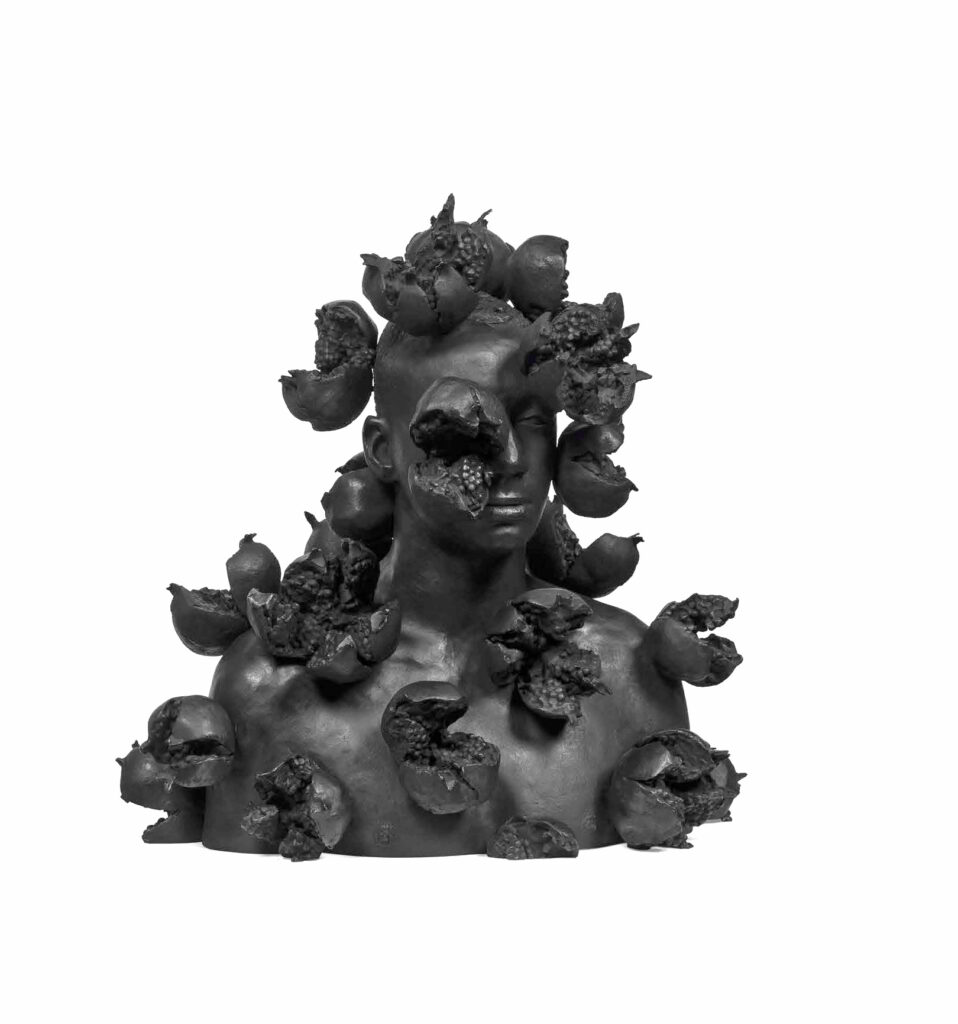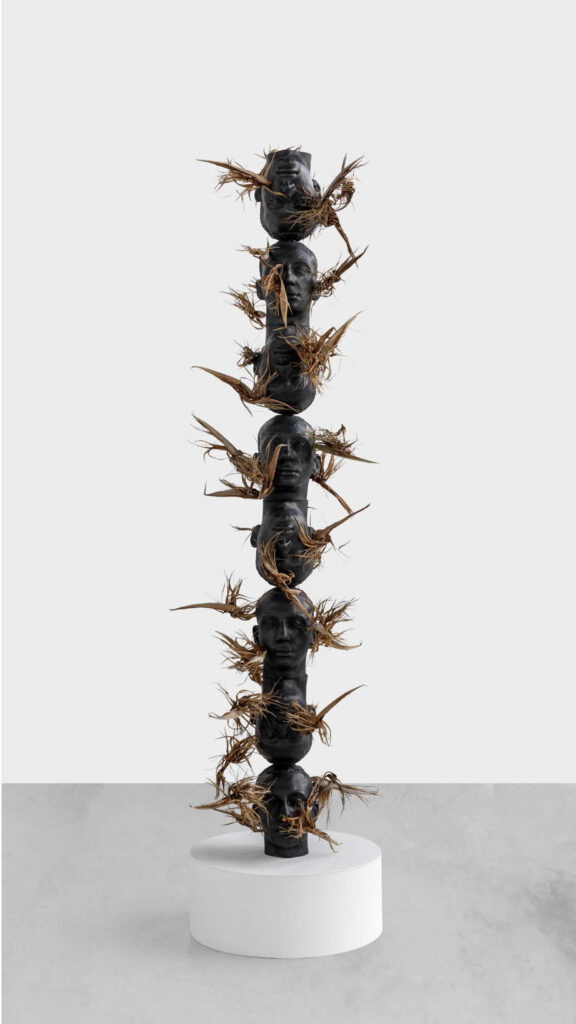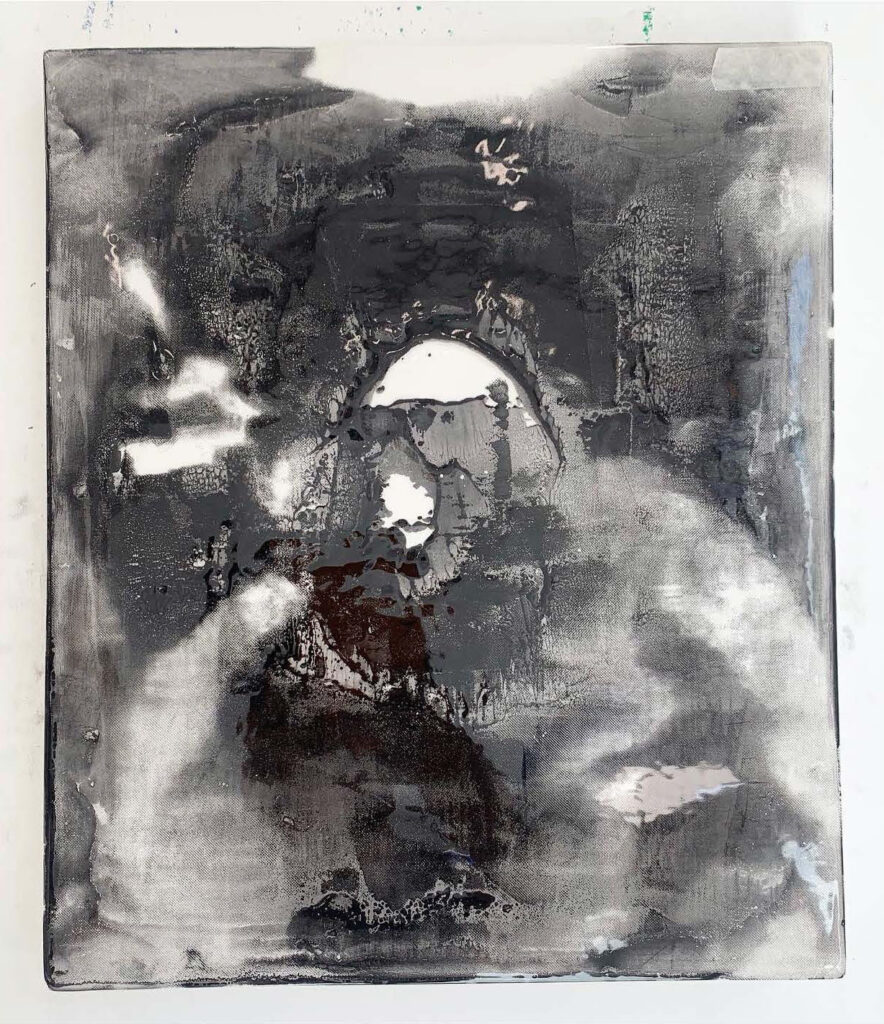Mehdi-Georges Lahlou | Looking for Simurgh
Looking for Simurgh is the newest solo exhibition by artist Mehdi-Georges Lahlou. The show presents a new body of work composed of bronze, ceramic, and charcoal sculptures as well as manipulated archival pictures and enamel prints. In this exhibition, Mehdi-Georges Lahlou contrasts realism with abstraction and thus continues his exploration of violence and desire by triangulating personal experiences, ancestral history, and self-representation. Fixed and analogous, his objects complicate history and offer a pause in moments of momentum and motion. The works exhibited are all in various hues of black, a new direction for the artist whose sculptures usually feature an array of vibrant colors.
A byproduct of combustion, a thin layer of powder matte charcoal covers the surface of a series of photographic archival prints, Of the Confused Memory – April 22, 1915 (2022). Applied by hand, the material transfers the texture of the paper while almost totally obscuring the visual contents of the images. Looking closely, one can spot outlines of bodies, like ghost images embedded within the textured black charcoal. The underlying archival images, sourced from the archives of the In Flanders Fields Museum in Belgium, document the damage caused after the first use of mustard gas, or sulfur mustard as it is also known, a chemical warfare agent that was used extensively during World War I. While it is well known that the gas was used on French troops, what isn’t commonly known—or properly remembered—is that the first soldiers to experience the brutality of chemical warfare were largely North Africans, known as the Algerian, Tunisian, and Moroccan Riflemen (tirailleurs) respectively. Mehdi-Georges Lahlou worked from photographs taken on April 22, 1915—the date of the first use of mustard gas—in the archives that specifically depicted North Africans. Pointing toward the colonial reality of this erasure, Mehdi-Georges Lahlou’s treatment of this archive makes the extreme violence of not just this history but how it’s recorded both visible and urgent.
Appearing differently, charcoal covers the surface of Birds of Paradise (2022), a pole made of cast ceramic molds of a male head. The totem is generously decorated with dried-out bird-of-paradise flowers, a tropical plant that is typically multicolored but appears brown when dried out. A stack of eight heads, the work juxtaposes intergenerational memory through the motif of the totem pole, a form used by indigenous people on the Northwestern coast of America to commemorate their ancestors, with the sense of celebration, fluidity, and vibrancy brought about by the artist’s inclusion of bird-of-paradise flowers. The addition of the matte black finish on this pole forces questions about race, desire, fetish, and self-representation, especially since the heads are modeled after the artist.
Sexuality and desire come up again in Of the Grenadier (2022), a black bronze bust featuring exploding pomegranate fruits colliding all around its exterior. In many non-Western cultures, pomegranates signify sin, seduction, and desire. They are even believed to be the forbidden fruit of the garden of Eden. In French, the word ‘Grenade’ means either pomegranate or grenade. Similarly, ‘Grenadier’ refers to either a soldier or a pomegranate tree. Of the Grenadier (2022) plays with this linguistic duality by contrasting the beauty of the black bust and the softness of the pomegranate with the harshness of the bronze and the visual distress of the exploding fruits. On one hand, this bust could be viewed as a figure under attack, being assailed by an outside source. On the other, one could interpret the pomegranates as emerging from the figure’s skin itself, erupting and exploding on its surface, suggesting a figure imploding and self-destructing from within.
The concept of self-destruction of the self, or destruction of individuals from within a community, is centered in Casablanca, March 25, 2016 (2022), a set of nine (three of which are shown) faience rectangle wall pieces lightly covered in black enamel. Mehdi-Georges Lahlou returned once more to the archives for this work, which documents an event of doubled violence that took place in Morocco on March 25, 2016. Mehdi-Georges Lahlou centers our attention on an image of a male couple covered in blood after being assaulted at home. The image emerged on various media platforms globally. By highlighting its over-circulation while also potentially pointing to our desensitization to seeing atrocity, the artist creates a pattern by reprinting the same image nine times and treating it with black varnish, resulting in a repeated image that is nonetheless different each time.
Looking for Simurgh borrows its title from The Conference of the Birds (1177), a poem by the Persian Sufi poet Farid ud-Din Attar commonly known as Attar of Nishapur. In the poem, the birds of the world go on a search for Simurgh, a benevolent bird in Persian mythology and literature, to be their leader as they have none. The poem represents a notion of self-acceptance and interconnectedness. It highlights the inevitably of the journey to get to those notions of connection. As it is with the artist’s overall practice, Mehdi-Georges Lahlou’s new body of work is as spatially aware as it is concerned with the body and its representations in media, history, and collective imaginary. His work calls for a more careful look at historical representations while demanding opacity at the same time.
Text by Yomna Osman (Curator and Art Writer)
Opening Sunday 18 September, 2 – 6 pm
reception Corsendonk bier
Open: Friday, Saturday & Sunday, 2 – 6 pm


